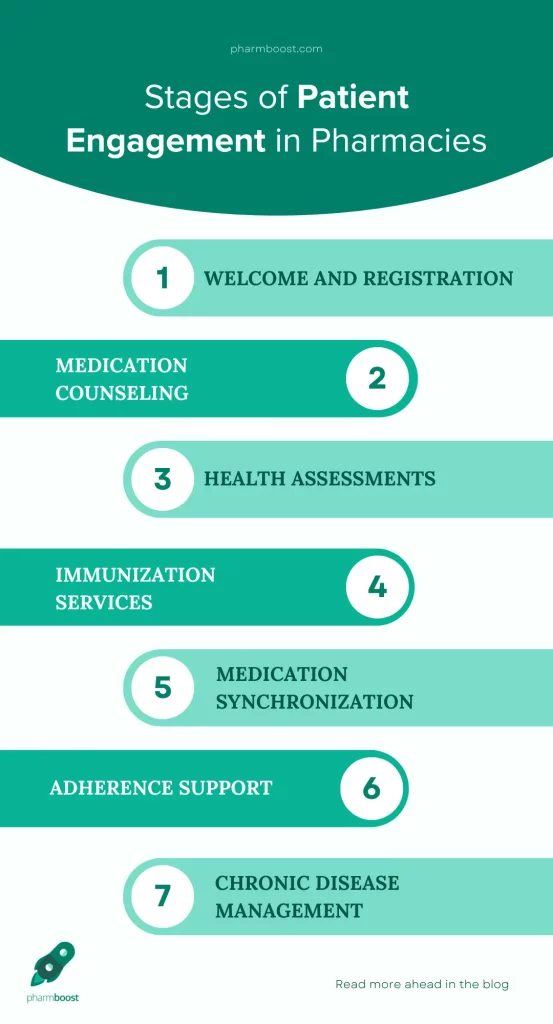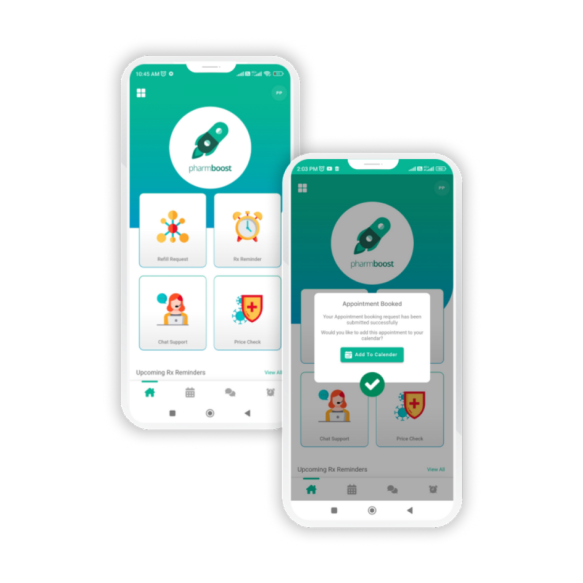Patient Engagement in Healthcare sector: All you need to know.
Patient engagement encompasses a spectrum of activities and interactions that involve patients actively in their healthcare journey. At its core, it's about encouraging patients to take an active role in managing their health. For instance, patients tracking their symptoms through mobile apps, participating in online health communities, or adhering to prescribed treatments are all examples of engaging with patients. These activities not only enhance patient satisfaction but also contribute to better health outcomes.
Stages of Patient Engagement in Pharmacies
Patient communication & engagement in pharmacies is a multifaceted process that evolves through different stages. Understanding these stages is crucial for developing effective strategies to foster communication with patients. Let's delve into each stage and explore how pharmacies can navigate them successfully.

- Welcome and Registration:
- Greet patients warmly and create a welcoming environment.
- Collect and update patient information, including contact details and insurance information.
- Medication Counseling:
- Provide comprehensive information about prescribed medications.
- Discuss proper usage, potential side effects, and any precautions.
- Encourage patients to ask questions and address concerns about their medications.
- Health Assessments:
- Offer health assessments or screenings to identify potential health risks.
- Use assessment results to tailor recommendations for the patient's well-being.
- Immunization Services:
- Provide information and administer vaccines as appropriate.
- Encourage patients to stay up-to-date on immunizations for preventive care.
- Medication Synchronization:
- Offer medication synchronization services to simplify prescription refills.
- Coordinate multiple medication refills to align with a single pick-up date.
- Adherence Support:
- Implement strategies to improve medication adherence.
- Use reminder systems, packaging aids, or adherence counseling to support patients.
- Chronic Disease Management:
- Work with patients managing chronic conditions.
- Develop personalized care plans and monitor progress over time.
- Provide ongoing education and support for managing chronic diseases.
- Telepharmacy (Online) Services:
- Utilize telepharmacy services for remote consultations.
- Offer virtual appointments for medication reviews, consultations, and follow-ups.
- Patient Education Programs:
- Conduct educational programs on health and wellness topics.
- Distribute informational materials on medication management, lifestyle changes, and preventive care.
- Community Engagement:
- Participate in community health events and fairs.
- Establish partnerships with local healthcare providers and community organizations.
- Feedback and Continuous Improvement:
- Solicit feedback from patients to assess the quality of services.
- Use feedback to make continuous improvements to enhance patient satisfaction and outcomes.
- Prescription Monitoring and Review:
- Regularly review patients' medication profiles.
- Identify and address any potential drug interactions, duplications, or safety concerns.
- Health and Wellness Services:
- Offer additional health and wellness services such as blood pressure monitoring, cholesterol screenings, or smoking cessation programs.
List of Patient Engagement Activities (Practical Ideas)
To truly engage patients, pharmacies can implement a variety of activities at each stage of the engagement process. Here is a curated list of activities that can enhance engagement in pharmacies:
1. Health Literacy Workshops
Conduct workshops to improve health literacy, empowering patients to make informed decisions about their well-being.
2. Interactive Webinars
Organize webinars on health topics, encouraging patient participation and providing a platform for addressing queries.
3. Virtual Support Groups
Establish virtual support groups for patients facing similar health challenges, fostering a sense of community and shared experiences.
4. Medication Adherence Programs:
Implement programs that assist patients in adhering to their medication regimens, combining educational resources with timely reminders.
5. Loyalty Programs:
Introduce loyalty programs to reward patients for consistent engagement, promoting long-term commitment.
6. Appointment Reminders for Better Patient Engagement
Efficiently incorporate automated appointment reminders through SMS, WhatsApp, or email, streamlining communication channels for timely notifications.
Additionally, grant patients flexibility in scheduling and rescheduling appointments, allowing them to manage their healthcare appointments conveniently.
To enhance the overall patient experience, ensure clarity by providing explicit instructions for pre-appointment preparations, empowering individuals to prepare adequately for their scheduled healthcare engagements.
7. Patient Portals for Communication
Enable secure messaging between patients and providers, facilitating communication and information sharing.
8. Medication Reminders & Tracking
Facilitate proactive patient care by offering assistance with medicine reminders and tracking, ensuring they adhere to their medication schedule without overlooking doses. This approach not only demonstrates a commitment to their well-being but also actively contributes to improved health outcomes.
9. HIPAA Compliant Chat Support
Patients today need convenience and real-time communication. Implementing HIPAA-compliant chat support in your pharmacy allows patients to easily connect with pharmacists for medication questions, refills, appointments, and personalized support, all through a convenient chat window.
10. HIPAA Compliant Chat Support
Patients today need convenience and real-time communication. Implementing HIPAA-compliant chat support in your pharmacy allows patients to easily connect with pharmacists for medication questions, refills, appointments, and personalized support, all through a convenient chat window.
Patient Engagement Platform: Pharmboost

Pharmboost goes beyond basic appointment booking, offering a comprehensive solution that seamlessly integrates with existing workflows. Moreover, it empowers pharmacy staff and delights patients by transforming the overall pharmacy experience. Additionally, Pharmboost's innovative approach not only enhances efficiency but also fosters a positive environment, ensuring a smooth and enjoyable interaction for both pharmacy professionals and patients alike.
Pharmboost acts as a central hub for patient communication and engagement activities, providing features such as personalized health tracking, interactive communication channels, and appointment scheduling. Additionally, its user-friendly interface ensures that both patients and pharmacy staff can navigate the platform with ease. Moreover, Pharmboost enhances the overall patient experience by seamlessly integrating these features for streamlined communication and efficient healthcare management.

Conclusion
In conclusion, patient engagement is a dynamic process that requires continuous effort and commitment from pharmacies. As demonstrated through the stages, activities, and the role of platforms like Pharmboost, patient communication & engagement goes beyond mere interactions—it's about building lasting connections that contribute to improved healthcare outcomes.
Pharmacies that successfully navigate the stages of engaging with patients and implement a diverse range of activities are not only meeting patient expectations but also creating a foundation for loyalty and positive health outcomes. Ultimately, patient communication in healthcare is a collaborative journey where empowered patients and proactive pharmacies work together to achieve optimal well-being.
Recent Post
- 5 Actionable Tips to Improve Patient Engagement within 1 Month
- Social Media Check List for Pharmacy Social Media Marketing
- Pharmacy Social Media Marketing 13 dos and don’ts to know
- Patient Engagement Barriers in Your Pharmacy & How Software Can Help You Overcome Them
- How to Attract New Patients and Boost Sales with Local Pharmacy Marketing







